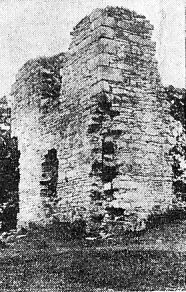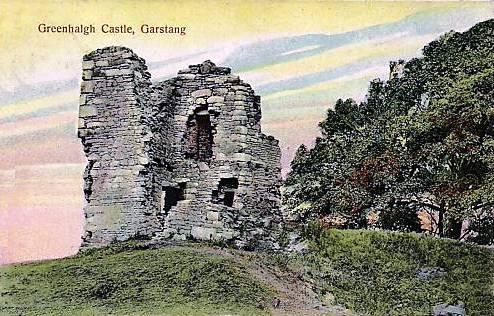Lytham St.Annes Express, Thursday April 18th, 1935
Greenhalgh Castle
HENRY VII BARONIAL
CASTLE.
Demolished After a Long Siege in 1646.
NEAR GARSTANG.
By R.G.S.
 QUITE recently I met a puzzled man
from Pilling. He had been pulling down an old cottage. The walls were of
the common type, shells packed with rubble, and the beams were black oak
pinned with wooden pegs. QUITE recently I met a puzzled man
from Pilling. He had been pulling down an old cottage. The walls were of
the common type, shells packed with rubble, and the beams were black oak
pinned with wooden pegs.
In part of the construction, however, sandstone had been
used, and he did not know its origin, because there is no such stone in the
village, and at the time when the cottage was built the materials nearest at
hand were always utilised.
I said that perhaps the stone came from Greenhalgh Castle,
just outside Garstang. When the castle was demolished in 1646, and only the
present stump left standing, a good deal of the material was used for building
in the district, and as years went on it was almost all taken away.
The events that preceded the demolition of Greenhalgh Castle
are so interesting that I am surprised they are not more generally known.
The castle was built by the Earl of Derby in the time of
Henry VII, when the barons were still a power in the land. The buildings were
in a rectangle around a great central courtyard, and there was a tower at each
corner. At the foot of the hill on which the ruins stood was a swamp,
supplemented by a moat for which it supplied the water.
The swamp has been drained for many years, but you may still
trace the site of the moat.
Unchanged
Country.

The country it commanded, I suppose, has changed less than
the castle. Then as now the young Wyre wound out of the hills, where wooded
slopes rose to the blue fells, and old Garstang town lay down in the
hollow. Leland, that indefatigable traveller who went everywhere and wrote
down what he saw, visited Garstang on a May day in 1535, and noted a "pretty
castle of the Lord of Derby's."
The siege of the castle, which began in 1846 and ended
in its destruction the following year, was recorded by a Puritan writer of the
time, and further traces of it may be found in the registers of Churchtown
Church. The war between King and Parliament had been dividing the Fylde
for some time when, on a day in May, 1645, Captain Nicholas Anderton. of
Claughton, whom our chronicler describes as " a most desperate Papist," took
possession of the castle and stayed there.
Almost at once Roundhead forces, based on Garstang, began
the long siege, and there must have been great excitement in the town. What
happened, according to the Puritan writer, was as follows:—
Laid Close
Siege.
"Colonel Dodding with his regiment, with Major Joseph
Rigby's cannons, laid close siege to Greenhalgh Castle, keeping their main
court at Garstang town.
" Into the castle were gotten many desperate Papists. Their governor was the
one Mr. Anderton. They vexed the country thereabouts extremely, fetching in the
night many honest men from their houses and making a commodity of them. They
sallied out oft, and killed some.
"They stood it out stoutly all through the winter. The country was put to
extraordinary charges in maintaining the men, who made a prey without pity,
such an abundance of provision they weekly destroyed.
"The leaguers thought to have undermined the castle and blown it up with
gunpowder. At great cost they spent much to pioneers, but to no effect, for the
ground was so sandy that it would not stand.
"At last this Anderton died, and they through watching being thereby
discouraged. they were glad to come to a composition to deliver the castle up
upon conditions. which were that they should go to their own houses and be
safe.
"It was ordered that the castle should be demolished and made untenable, and al
the timber taken out of it and sold. which was done. And so it lies
ruinated.
" It was very strong, and built so that it was impregnable with anv ordnance
whatsoever, having but one door into it, and the walls of an exceeding
thickness and very well secured together."
Five Feet
Thick.
You can still see how true his words were. There are the
remains of a tower 24 feet square, made of rubble sandstone, and the walls are
five feet thick. You may stand on the hill and look down to the town, imagining
how the attackers came up those same slopes, and how the defeated garrison
later walked down them. You may think also of the castle 100 years before that,
as Leland saw it when he crossed " the great stone bridge over Wyre."
|